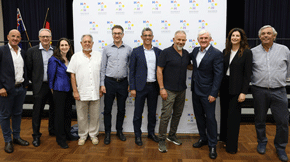Fred and Ric go Head to head
The subtlety of Chopin and the roar of a Wagnerian super-orchestra offered vivid contrasts to a near capacity audience at the SSO Master Series concert last night, writes Fraser Beath McEwing.
The night began quietly, with English conductor Mark Wigglesworth and Argentinean pianist Ingrid Fliter heading up a small section of the Sydney Symphony Orchestra in Chopin’s second piano concerto.
From the opening treble chord, Fliter owned this concerto. She never seemed hurried, always finding time to put her own stamp of rubato on it. She was able to fill the sound palate, from assertive statements to barely- there, perfectly even ornaments.
The slow movement was outstanding. The story goes that the 19-year-old Chopin had just fallen in love when he wrote it. Fliter carried this interpretation through with some of the most romantic playing I’ve heard in a long time. This, of course, was enhanced by her cascades of free flowing brown hair and her swaying body movements at the keyboard.
Maybe she picked up the idea from her compatriot, Martha Argerich, whose now greying hair is still as volcanic as her playing.
Fliter also made a fashion statement. From the back she appeared to be wearing black, feminised tails, but when she tuned around to bow, she showed the front of a glittering sequinned dress that Liberace might have made into a jacket – or maybe left as a dress.
I digress. As you can see, I’m suffering Fliter-fascination. Suffice to say that even if you’d left at intermission, as several did in a protest against Wagner’s cultural preferences, Fliter’s Chopin alone was worth the money.
Take the 15 hours of Wagner’s Der Ring des Nibelungen cycle, remove the singers and scenery, and condense what you’ve got left into one hour with some orchestral tweaks and you’ve got the second half of the SSO program.
Dutch percussionist and composer, Henk de Vlieger did just this in 1990 to compose ‘The Ring – An Orchestral Adventure’. It would be unkind to call this Wagner for Dummies, although I did overhear the comment on my way down the stone steps. Essentially, it pulls out the orchestral essentials of the Ring and fits them into an hour of continuous, strikingly vivid and exciting music. And what a whopper orchestra it takes. Musicians were shoehorned in to fill the opera house stage. In addition to a full complement of strings (which included eight double bases looking like a prehistoric engine) were four harps (Wagner preferred eight), three each of most woodwinds when the usual number is two, and enough brass to rip open the roof. The percussion section lined up like the cavalry along the back with two sets of timpani, drums, and a whole lot of other bangables. One of the most interesting instruments was the Wagner tuba, invented by Richard to bridge the gap between horns and trombones. There were four of them, fiercely shiny, and producing an appealingly mournful sound that I’d like to hear again.
This huge orchestra had been assembled to play for one hour only. Although I literally loved Ingrid Fliter, I wondered why the evening had not put this mighty team through its paces with other colossal pieces instead of sitting at least 50 of the players in the green room cooling their heels for half the night.
This was not the only time that the SSO had tackled the Wagner/de Vlieger piece. It was first played in 1993 to welcome the incoming Edo de Waat. Edo took another run at it with the SSO in 2006.
The work covers four sections, taking material from Rheingold, The Valkyries, Siegfried and Gotterdammerung. With all that firepower at his disposal, Wigglesworth extracted both enchanting and frightening sounds from the orchestra. It took a high level of skill to keep such powerful elements under control and demonstrated his masterful conducting.
The finale was very Wagnerian, as we waited through many promising build-ups for orgasm. But finally there it was, more gentle then expected, but rounding out a kaleidoscope of great variety and complexity.
Fraser Beath McEwing is an accomplished pianist and commentator on classical music performance and is a founding member of The theme & Variations Foundation Advisory Board which provides assistance to talented young Australian pianists. His professional background is in journalism, editing and publishing. He is also the author of three novels.He is a Governor of the Sir Moses Montefiore Home.













Great to read J-Wire covering SSO.
But when the soloist Ingrid Fliter is of Jewish descent, and Marthe Argerich is Jewish surely it should be noted.
The gorgeous encore by Fliter was a posthumous Waltz of Chopin’s.
As delighted as the audience was with the soloist, speaking to her after the concert, was her delight in playing in Sydney again.
a very lovely and talented lady
J-Wire was well aware of both Jewish connections. However, J-Wire believed it was appropriate to have this confirmed and requested the SSO to do so…and perhaps, if so, conduct an interview. The SSO is yet to respond.